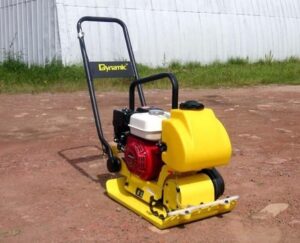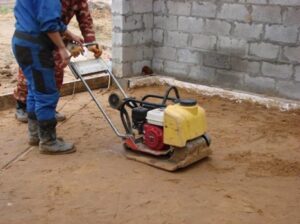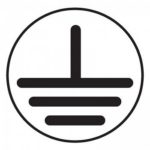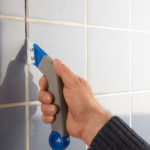Choosing a vibrating plate: operating principle, characteristics, reliability
Vibrating plate - This is a special device that is a self-propelled construction machine. It has a flat working surface that vibrates intensely due to the movements of an electric, gasoline or diesel engine. Thanks to this, sand or other bulk materials are well compacted and the surface is smooth. The main types of equipment and recommendations for their selection are described in this material.
The content of the article
Description and principle of operation
We can say about a vibrating plate that it is a tool for effectively compacting sand, crushed stone or other bulk materials. Outwardly, it resembles a small road roller. The unit is based on a working plate. A motor frame, a centrifugal clutch, the engine itself and a vibrator are mounted on it.
The main elements are enclosed in a cylindrical metal case. The motor frame is mounted on shock absorbers. An engine running on electricity, gasoline or an engine is installed on it. It is he who defines what a vibrating plate is. The engine's energy is transferred to the shaft, where a centrifugal clutch is installed. It rotates at a frequency of about 2200 revolutions every minute.

Through transmission, torque is supplied to the vibrator shaft and then to the working flat surface. It vibrates intensely, interacting with bulk material.Therefore, we can say about a vibrating plate that it is a device that compacts sand, gravel, and crushed stone due to the intensive operation of the engine.
Some devices also have a water tank. This increases the weight of the vibrating plate, but it allows you to immediately irrigate the surface being treated. The device can also be equipped with shock-absorbing mats, gloves and other elements that make the operator’s work more comfortable.
Types of vibrating plates
To understand how to choose a vibrating plate, you need to understand what types of devices there are. Depending on the features of the device, you can understand why a vibrating plate of one type or another is needed. There are 4 categories based on weight:
- Up to 90 kg - These are lightweight machines that are used for domestic purposes, as well as in agricultural work.
- Lungs – weighing in the range from 90 to 200 kg. The equipment is used for laying coarse soil, for example, gravel, as well as asphalt.
- Average – within 200-500 kg. They are used for processing coarse-grained soil, including compacting large layers.
- Heavy – weighing from 500 kg. Used for strong surface compaction.

When choosing, you need to understand the operating principle of the vibrating plate and its purpose. For example, for a layer up to 15 cm, you can use lightweight models. If you need to lay 20-25 cm, light and medium-sized devices are suitable. If the layers are large, from 30 to 60 cm, a heavy machine is definitely needed.
The unit may have one or several shafts. Depending on this, there are 2 more types:
- single-shaft (moves only forward);
- reversible (several shafts, can move forward and backward).
Depending on the type of engine, there are 3 more types:
- Gasoline – a universal model with high performance and at the same time affordable price. The rating of the best models of gasoline vibrating plates includes several different options that can be used at home and for professional purposes.
- Diesel – it does not occur as often as compared to gasoline. Used to save fuel.
- Electric – the most affordable model. Moreover, it can also be used indoors.

It is also useful to figure out which is better – a vibrating plate or a vibrating leg. The latter are designed for compaction in hard-to-reach places, for example, in a small trench. Its working surface is smaller than that of a vibrating plate, and compaction is much more intense. We can say that both tools are useful, but for different types of work.
One more point: which is better – a vibrating plate or a vibrating rammer. In the latter case, the engine communicates not vibrating, but pushing motion in the direction of the surface. Therefore, the intensity of the impacts is much higher, although the treated area is smaller. Such equipment can also be used in hard-to-reach places. But it is not suitable for laying tiles, asphalt or compacting clay soil.
Other selection criteria
The choice of vibrating plate should be made taking into account other parameters:
- The presence of a wheel set will make moving such equipment much easier.
- The folding handle is another important characteristic of the vibrating plate. The presence of a handle makes it easy to transport the device.
- Irrigation system - it is not available everywhere, but it is desirable that such equipment exists. The system irrigates asphalt or other surfaces. Only some types of vibrating plates have them.
- Protective cover – to prevent the ingress of dirt, stones, sand and other materials. The vibrating plate also has vibrating legs.

It is also recommended to pay attention to the characteristics of a gasoline vibrating plate. First of all, this is power, engine type, its stroke and tank volume. A very important parameter is the depth of compaction and the dimensions of the slab itself. Based on these indicators, you can see the differences between a vibratory rammer and a vibrating plate.
Among the technical characteristics of a vibrating plate, power is of particular importance. This parameter is measured in Watts and horsepower. For example, a fairly good compaction depth of 350 mm requires a vibrating plate power in the range of 4500-4800 W. For domestic purposes, you can use less efficient devices.
The selection of a vibrating plate for tamping can also be done taking into account the manufacturer’s brand. Judging by the reviews and technical characteristics, the best representatives are:
- Ammann;
- Zitrek;
- Champion;
- Elitech;
- DDE;
- RedVerg and others.

Thus, you can choose a suitable device depending on its purpose, layer depth, and required power. If we talk about which vibrating plate is best to buy for asphalt, these are light and medium models weighing 90-120 kg. If maximum compaction of large layers of 30-60 cm is required, you should opt for heavy models. It is also necessary to take into account the power, engine type and the presence of additional accessories.





